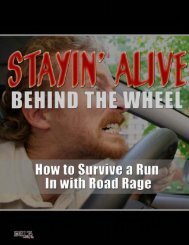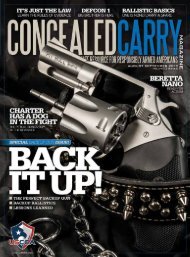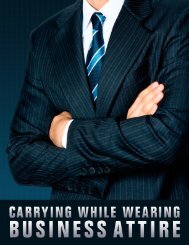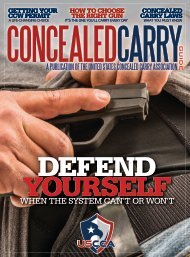Download This Issue - US Concealed Carry
Download This Issue - US Concealed Carry
Download This Issue - US Concealed Carry
Create successful ePaper yourself
Turn your PDF publications into a flip-book with our unique Google optimized e-Paper software.
THE WARRIOR EXPERT<br />
this. Watching any world class competitor<br />
take out a plate rack is awe inspiring,<br />
but unless they are being attacked<br />
by a bunch of guys who are duct-taped<br />
together and will go down with one hit,<br />
the skill is not a useful one for defensive<br />
shooting. When you don’t know that the<br />
targets are going to be in the exact same<br />
place and you must shoot and assess<br />
(question #4) because you don’t know<br />
how many shots you’ll need to fire at<br />
each target, techniques developed for<br />
shooting multiple pieces of steel will be<br />
irrelevant.<br />
Questions 5, 6, 7, and 8 are directly<br />
related to the condition of our brains<br />
and bodies when we are performing<br />
our skills. It is very well documented<br />
that there are predictable changes that<br />
take place throughout our system when<br />
we are startled, scared, and in a life and<br />
death fight. The degree of these changes<br />
may vary, but their existence is about as<br />
close to an absolute as we can have in a<br />
real fight. <strong>This</strong> article is not the place to<br />
detail the various natural reactions, but<br />
they include changes in blood flow, heart<br />
rate, vision, motor control, and the perception<br />
of time. If you want to brush up<br />
on the details, I cover the most important<br />
ones in my books, but Mike Martin does<br />
an even better job in his, Fundamentals<br />
of <strong>Concealed</strong> <strong>Carry</strong>. These changes are<br />
significant and they will impact performance.<br />
While we can’t really simulate<br />
them in our training environment, we<br />
should choose to train techniques and<br />
tactics that take them into account, not<br />
simply accept that something is a good<br />
idea because it “can” be done or works<br />
well in another type of shooting.<br />
Question #1 is the only question that<br />
I haven’t addressed. Its relevance is<br />
much more about what you choose to<br />
purchase and train with before your incident.<br />
If you only own one type of gun<br />
and carry it, it is fair to say that you have<br />
an incredibly high likelihood of being<br />
able to answer this question accurately.<br />
The answers to the other questions and<br />
the skills you choose to develop should<br />
strongly influence what type of gun you<br />
choose. Choosing one that excels in other<br />
types of shooting could be like entering<br />
a tractor pull with a Ferrari. Choose<br />
the right tool for the job you’ll need to<br />
do, under the conditions that you’ll most<br />
likely need to do it.<br />
Go back and look at the questions<br />
again with a thought to the worst-casescenario<br />
defensive shooting; No, not<br />
zombies at the movie theater, just a<br />
single attacker situation where most of<br />
the questions are unanswerable because<br />
you are truly caught off guard. We call<br />
this the Ambush. True defensive shooting<br />
should be done from the approach of<br />
Counter Ambush Training. The foundational<br />
requirement for any training to be<br />
truly Counter Ambush is The Processing<br />
of Information prior to the Execution of<br />
any Learned Skill.<br />
Without that important component,<br />
you are merely shooting free throws instead<br />
of training for the conditions of the<br />
The Warrior Expert Theory<br />
The Warrior Expert Theory states<br />
that through frequent and realistic<br />
training, one can become capable<br />
of using the power of recognition<br />
to make responses during a dynamic<br />
critical incident more efficient.<br />
WET is a simple theory that has huge<br />
ramifications on the way we train and<br />
what we choose to train in the first<br />
place. Recognition is the method of an<br />
expert. You can only “recognize” something<br />
if you have been exposed to it previously.<br />
Experts are people who have<br />
spent a significant amount of time being<br />
exposed to a specific area of study<br />
and are able to capitalize on their ability<br />
to recognize information related to it.<br />
In my book, Combat Focus® Shooting:<br />
Evolution 2010, I talk about chess players<br />
and doctors as typical experts in<br />
their areas. They can often make accurate<br />
diagnoses or choose appropriate<br />
moves without long periods of research<br />
or cognitive processing because they<br />
recognize patterns of information in<br />
their observations. As a person interested<br />
in self-defense, we need to be a<br />
Warrior Expert. We need to seek out opportunities<br />
to be exposed to the stimuli<br />
that represent threats and the appropriate<br />
responses to those threats frequently<br />
and realistically so that, in the worst<br />
case scenario, we don’t have to take a<br />
lot of time to cognitively process, make<br />
decisions or execute complex learned<br />
responses (like drawing and shooting a<br />
gun).<br />
The Warrior Expert Theory covers<br />
both the soft side of decision making<br />
and the hard side of skill performance.<br />
In the brain, what we have commonly<br />
referred to as “muscle memory” is actually<br />
created by the strengthening of the<br />
connections between neurons in the<br />
brain that are used to perform physical<br />
skills. <strong>This</strong> strengthening is actually<br />
a physical thinning of the gap between<br />
the frequently used neurons through<br />
repeated layering of fats when the connection<br />
is used. The thinner the gap, the<br />
less time it takes for an electrical signal<br />
to be passed between the neurons, the<br />
faster an action can be performed and<br />
the easier it is to perform it. Given the<br />
choice between a relatively wide gap<br />
(an unrehearsed action) and a well established<br />
thin gap, a charge is more<br />
likely to follow the path of least resistance.<br />
<strong>This</strong> can be seen as physical skill<br />
recognition.<br />
Knowing that our training resources<br />
are always limited, the Warrior Expert<br />
Theory reminds us that we need to<br />
maximize their value by training as few<br />
tactics and skills as possible (to increase<br />
the “frequency” of exposures and repetitions)<br />
and train in the context that we<br />
will need them (“realistically” based on<br />
plausibility).<br />
<strong>This</strong> column will take the title<br />
“Warrior Expert Theory” and will use<br />
WET as a backdrop for everything that<br />
I discuss. Developing recognition level<br />
responses means that you can take full<br />
advantage of your brain and body’s<br />
natural ability to work together and integrate<br />
with tools to help you get safe<br />
as quickly as possible when ambushed.<br />
Your automated system can “take over”<br />
when you need it most, if you prepare<br />
it. That preparation starts with sound<br />
principles and concepts that lead to the<br />
development of efficient techniques<br />
and well reasoned tactics. H<br />
32<br />
<strong>US</strong>CONCEALEDCARRY.COM n CONCEALED CARRY MAGAZINE n MAY/JUNE 2011
















